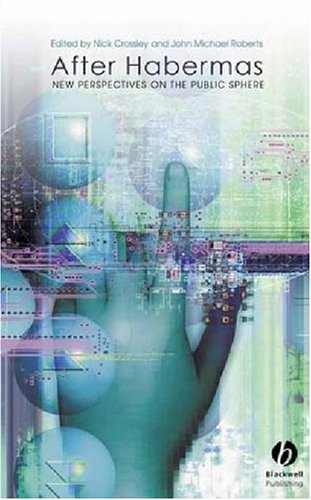After Habermas: New Perspectives on the Public Sphere (Sociological Review Monograph)
Crossley, Nick and Roberts, John Michael
Blackwell Publishers, Oxford
2004
1405123656 (pb)
 After Habermas: New Perspectives on the Public Sphere, a collection of essays contemplating the contributions that Jürgen Habermas's work on the public sphere has made to contemporary social theory, could easily have been titled 'Before Habermas' or 'Beyond Habermas'. Most of the essays in this collection use Habermas's thinking on the public sphere—specifically his conception of idealized, rational speech and the demise of the brief golden age with the onset of mass media—as a foil against what are argued by many of the authors in this volume to be the more robust theories of the public sphere and the nature of political communication within it as developed by Mikhail Bakhtin, Pierre Bourdieu and John Stuart Mill. Some of this volume's more interesting chapters, such as Chapter 1 ('Wild Publics and grotesque symposiums: Habermas and Bakhtin on dialogue, everyday life and the public sphere,' by Michael Gardiner), and Chapter 2 ('Justice and drama: on Bakhtin as a complement to Habermas,' by Ken Hirschkop) make strong arguments for reconsidering the public sphere from a Bakhtinian perspective by presenting his heterglossia concept, or public dialogue that is subjective, polyphonic, value-laden and open-ended, as an alternative to the Habermasian elitist, rational and consensual public sphere that have not been made in early critiques of Habermas. Chapter 5 ('Habermas and social movements: what's 'new'? by Gemma Edwards) and Chapter 6 ('Expanding dialogue: the Internet, the public sphere and prospects for transnational democracy,' by James Bohman) also provide much needed rethinking on assumptions made both by Habermas himself as well as those scholars using his conception of the public sphere to frame their own analysis of the democratic potentials of Internet-based political dialogue or new social movements. Both essays challenge previous thinking that has been overwhelmingly based on the reductive limitations of the Habermasian public sphere to theorise more contemporary phenomena such as online discussion boards or social movements rooted in identity or environmental justice.
After Habermas: New Perspectives on the Public Sphere, a collection of essays contemplating the contributions that Jürgen Habermas's work on the public sphere has made to contemporary social theory, could easily have been titled 'Before Habermas' or 'Beyond Habermas'. Most of the essays in this collection use Habermas's thinking on the public sphere—specifically his conception of idealized, rational speech and the demise of the brief golden age with the onset of mass media—as a foil against what are argued by many of the authors in this volume to be the more robust theories of the public sphere and the nature of political communication within it as developed by Mikhail Bakhtin, Pierre Bourdieu and John Stuart Mill. Some of this volume's more interesting chapters, such as Chapter 1 ('Wild Publics and grotesque symposiums: Habermas and Bakhtin on dialogue, everyday life and the public sphere,' by Michael Gardiner), and Chapter 2 ('Justice and drama: on Bakhtin as a complement to Habermas,' by Ken Hirschkop) make strong arguments for reconsidering the public sphere from a Bakhtinian perspective by presenting his heterglossia concept, or public dialogue that is subjective, polyphonic, value-laden and open-ended, as an alternative to the Habermasian elitist, rational and consensual public sphere that have not been made in early critiques of Habermas. Chapter 5 ('Habermas and social movements: what's 'new'? by Gemma Edwards) and Chapter 6 ('Expanding dialogue: the Internet, the public sphere and prospects for transnational democracy,' by James Bohman) also provide much needed rethinking on assumptions made both by Habermas himself as well as those scholars using his conception of the public sphere to frame their own analysis of the democratic potentials of Internet-based political dialogue or new social movements. Both essays challenge previous thinking that has been overwhelmingly based on the reductive limitations of the Habermasian public sphere to theorise more contemporary phenomena such as online discussion boards or social movements rooted in identity or environmental justice.
Primarily using Habermas's seminal work The Structural Transformation of the Public Sphere (1962, 1989), especially the 1989 English translation, as the jumping off point to theorise the public sphere, most of the chapters position their critique on this earlier work of Habermas at the expense, at times, of his later thinking. Many of the 'new perspectives' presented in this book are actually based on work that was done in the 19th or early 20th centuries by the likes of Mill and Bakhtin. Less attention is given to Habermas's work that came after his Structural Transformation, namely Theory of Communicative Action (1987) and Between Facts and Norms (1996), where he modified and revised his communicative public sphere theory in response to, in part, the overwhelming critiques of his ideas, especially his idea that a rational, non-ideological, non-subjective speech situation is central to the development of a liberal public sphere in response to state power. While Habermas's synthesis of the critiques of his earlier conceptions of the public sphere that appear in his later works is acknowledged in the introduction, most of the subsequent chapters remain focused on Structural Transformation which is unfortunate because although there are strong arguments made within the book for critical scholarship to move on from a Habermasian public sphere, inevitably, by maintaining a critical focus on it at the expense of his later thinking, the chapters in this book remain stuck in it.
Mary Ebeling
University of Surrey

